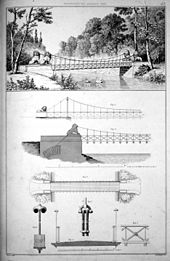Lion Bridge (Berlin)
Coordinates: 52 ° 30 ′ 45 ″ N , 13 ° 20 ′ 44 ″ E
| Lion Bridge | ||
|---|---|---|
| Former Lion Bridge in Berlin's Tiergarten | ||
| use | pedestrian | |
| Convicted | a pedestrian path across a bay of the New Lake | |
| place |
Berlin district Berlin-Tiergarten |
|
| construction | A stone pedestal for each of the (originally) four lions as bridge piers near the shore | |
| overall length | 17.30 | |
| width | 2.00 | |
| building-costs | around 2580 Reichstaler | |
| start of building | 1838 | |
| completion | 1839 | |
| planner |
Ludwig Ferdinand Hesse , Christian Friedrich Tieck |
|
| closure | 2014 | |
| location | ||
|
|
||
The Berlin Lion Bridge was a 17.3 meter long and around two meter wide pedestrian bridge in the Tiergarten in the Tiergarten district . After it had been closed since 2008 due to dilapidation, the wooden footbridge was removed in 2014 except for three of the four lions. The listed park bridge was located in the southwestern part of the zoo near the Fasanerieallee . It led over a watercourse that flows into the New Lake . Due to the destruction of the Borsigsteg and the old Hugo-Preuss-Bridge during the Second World War , the Löwenbrücke was not only the last remaining suspension bridge in Berlin, but also the oldest wire rope suspension bridge in Germany.
history

The bridge was created in 1838 based on designs by Ludwig Ferdinand Hesse and Christian Friedrich Tieck as a replica of the St. Petersburg Lion Bridge and is the first suspension bridge in Berlin. The filigree construction made of wood is hung with hangers made of iron rods on two iron parallel wire ropes, which are held in their mouths by four cast-iron lions sitting on high stone plinths, after which the bridge takes its name.

The animal figures were cast by August Borsig at the Oranienburger Tor based on a design by a student of Christian Daniel Rauch . While the Lion Bridge in Saint Petersburg - also designed by a German designer - is a chain bridge with thin iron bars, wire ropes made of adjacent wires were used here, which is why the design plans are called the Drath Bridge . In addition to the water-spanning function, the bridge was also a showcase project for the Borsig iron foundry, which had just been founded and which subsequently helped him to get new orders and rapid economic growth. The wooden railing between the lions was designed as a simple scissor-like ornament.
The construction costs in 1838 were 2578 Reichstalers and 21 silver groschen . Except for the lions, the structure was destroyed in World War II. When it was restored in 1958, the bridge was largely reconstructed true to the original.
Dilapidation and a new building postponed indefinitely
In 2008, the bridge was closed to pedestrians and cyclists, and the Senate Administration was concerned about safety due to significant damage to the wooden planks. A site fence was built around the bridge. For 2014, a “new bridge building in line with historic monuments based on the historical model” was planned. Instead, the bridge was removed in 2014 and only the lions, initially two on each bank, were left in place. The former accesses to the bridge were blocked by steel tube barriers. In response to a small request from the Left , the Berlin Senate Department for Urban Development and the Environment declared in 2015 that plans to build the new Löwenbrücke bridge had been postponed indefinitely due to a lack of staff in the office. In 2019 there were only three lions left in their original place.
See also
Web links
- Image of the destroyed bridge in 1945
- Short story of the Lion Bridge with numerous photos; the last picture from January 1, 2019 shows only three lions .
Individual evidence
- ↑ Jörg Niendorf: Borsig's debut with the lions . In: Berliner Zeitung , May 10, 2019, p. 6.
- ↑ Lion Bridge . In: District lexicon of the Luisenstädtischer Bildungsverein
- ↑ Entry in the Berlin State Monument List , see No. 008.
- ^ Pedestrian bridges in Berlin . Senator for Building and Housing, Berlin 1976, p. 14 f.
- ↑ Hanging section for the Lion Bridge . In: Der Tagesspiegel , September 3, 2011.
- ↑ Photo of the lions without a bridge with a tubular steel barrier
- ↑ Written request from Member of Parliament Carsten Schulz (LINKE) from August 18, 2015 and answer from the Senate Department for Urban Development and Environment from September 3, 2015

